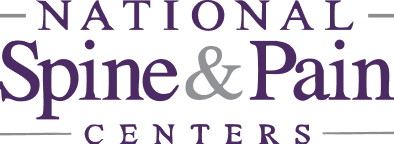Degenerative Disc Disease (DDD) describes the wear and tear in the spine that nearly everyone experiences with increasing age. It is not an actual disease but rather a condition where damaged discs cause neck or back pain. Magnetic resonance imaging (MRI) shows that most people over 40 have some damage to their discs. However, not everyone experiences neck or back pain.
In advanced cases, people may have pain and stiffness as the discs collapse, causing the surrounding (facet) joints to rub against each other. While DDD is not reversible or curable, the pain flare-ups that are associated with it can be treated. Understanding Degenerative Disc Disease can help you find the right treatments for your neck or back pain.
What causes DDD?
The discs in your back are water-filled shock absorbers between your backbones, allowing bending, twisting, and stretching in the spine. These discs are composed of two parts:
- The soft, jellylike core can leak out after an injury, causing swelling and pain in your neck or back.
- The tough outer layer has many nerves. If a disc tears in this area, it can be quite painful.
In young people, discs are rubbery and flexible. However, as we age, these discs begin to weaken and shrink. This is known as spinal disc wear-down (degeneration).
These are the most common causes of disc degeneration disease:
- Aging: As you age and experience repeated shocks to your spine, the discs lose their water content and dry out.
- Spondylosis: Spondylosis is a common, age-related condition that specifically affects the joints and discs in your neck. The common drying out and shrinking of your discs can lead to DDD, arthritis, disc herniation, or spinal stenosis.
- Daily activities and sports: Repeated wear and tear from lifting, running, or twisting can tear the outer part of the disc.
- Poor blood supply: While other tissues receive a generous supply of blood and oxygen, the disc is a fibrous tissue that receives only a low supply. This means that a disc repairs itself very slowly. It’s common for an injured disc to deteriorate over the course of 20 to 30 years.
- Trauma: Sudden forces applied to the spine, such as those that can occur in a car accident, can injure the discs.
- Genetic predisposition: “Bad backs” may run in families. You may have a higher risk for DDD if a parent or grandparent also suffers from it.
- Weak core muscles: The abdominal muscles, pelvic muscles, and some muscles around the spine are collectively known as “core” muscles. They provide support to the spine. Core muscle weakness (i.e., from prolonged hospital stays in bed) can lead to disc injuries.
What are the symptoms of DDD?
DDD is commonly found in the neck and lower back but can occur anywhere along the spine. The neck and lower back receive more strain with movement than other spine areas. DDD is a less common cause of neck/back pain when compared to other disc injuries, such as spinal arthritis or disc herniations. Disc herniations cause the disc to bulge out of its normal place between the backbones or to break apart.
However, the symptoms of DDD can differ. These are the symptoms to look out for:
DDD symptoms in the neck:
- Neck pain that may shoot into the arms and hands
- Pain that ranges from mild and nagging to severe and disabling
- Numbness and tingling in the arms, hands, and fingers
- Severe pain that comes and goes; may last from a few days to a few months
DDD in the lower back include:
- A dull ache and pressure across the lower back and into the buttocks
- Pain that is worse when sitting, bending, lifting, or twisting
- An improvement in pain when walking and moving
- Decreased pain when changing positions often or when lying down
- tingling in the legs
Can I cure DDD?
Unfortunately, DDD does not go away. Just like aging, you can’t reverse the process once your discs begin to degenerate. However, the pain caused by DDD can be treated.
DDD pain may flare up for several days or a few weeks. As the disc damage advances, flare-ups may become more frequent and longer lasting. The pain may even become constant.
The good news is that DDD pain flare-ups often improve with time and treatment. There are many treatments a pain specialist can offer that may prevent you from going to surgery.
When should I see a pain specialist?
You should see a pain specialist when your neck or back pain becomes moderate or severe or if the pain starts to interfere with daily activities like walking, driving, or sleeping.
A pain specialist will diagnose the cause of your neck or back pain based on your medical history and a physical examination. Your doctor may order these diagnostic tests:
- X-rays (radiographs) show bone defects and are often used to rule out other causes of back pain, such as fractures.
- Imaging scans, such as CT and MRI, gather information about the state of the spinal nerves and discs and how they are aligned.
- A discogram involves injecting a dye into the soft center of the disc to determine whether it is painful. The dye shows up on a CT scan or X-ray.
What is the right treatment for me?
Everyone’s chronic pain is different. That means treatment differs for everyone. A dedicated pain specialist can help diagnose your pain and find the right treatment for you, whether it involves controlling the pain or maintaining flexibility in the muscles that support the spine.
Some common treatments for DDD include:
Medications
- Over-the-counter medications treat mild-moderate pain. Nonsteroidal anti-inflammatory drugs (NSAIDs) like Ibuprofen (Advil), Aspirin, and others decrease inflammation and pain. For people who cannot take anti-inflammatories, acetaminophen (Tylenol) can help.
- Adjuvant medications are “helper” medications that are not painkillers but can reduce pain through other mechanisms. Antidepressants like Duloxetine (Cymbalta) and Amitriptyline (Elavil) treat nerve pain (tingling and numbness in the arms or legs). Muscle relaxants like Cyclobenzaprine (Flexeril) calm the muscles around your painful back area.
Physical therapy
Physical therapy improves your strength, flexibility, and range of motion. Back braces and hot/cold therapy may help, as well.
Pain-relief injections
- Epidural Steroid Injections (ESIs) place steroids, and sometimes numbing medicine, near the discs. Steroids reduce inflammation. An ESI is a quick procedure performed in a pain specialist’s office. While the pain relief is temporary, lasting for several days to months, it helps you to start physical therapy. Epidural injections can be repeated.
- Facet Joint Injections place steroid and/or numbing medicine in the facet joints that lie next to the damaged disc. When a disc dries out, the facet joints rub against each other, causing your neck or back pain. Facet joint injections can relieve pain over several days to several weeks.
- Regenerative treatments use stem cells from your bone marrow and platelet-rich plasma (PRP) from your blood to treat aging and painful discs. These treatments can also treat pain due to bulging or herniated discs.
Spinal Cord Stimulation (SCS)
Spinal Cord Stimulation (SCS) can relieve pain in a significant number of patients with low back DDD. This therapy is used when your chronic pain does not improve with the treatments mentioned above. A small device is placed in your back. This device sends electrical signals to your spinal cord in order to stop the pain.
Aurora ZIP Lumbar Fusion
Aurora ZIP Lumbar Fusion is a common minimally invasive procedure for back pain, where a spacer is placed between two to strengthen and straighten the spine. This is less invasive than traditional extensive back surgery that requires general anesthesia, a hospital stay, and several months of home recovery.
Surgery and other invasive procedures
Disc replacement is a surgery that replaces an unhealthy vertebral disc with an artificial disc made out of metal or plastic-like material. The artificial disc works like a normal disc – it carries load and allows movement.
What can I do to decrease the risk of DDD?
- Don’t smoke: Smoking slows blood flow to the discs and slows healing.
- Strengthen core muscles: It helps support the spine and reduce strain on your discs.
- Stretch: Stretching can provide relief and support for your back. If you feel pain, get up and move instead of lying down.
- Exercise: Extra pounds put pressure on your spine and increase back pain. Low-impact exercises can help strengthen your back.
- Eat well: A healthy diet helps you maintain a healthy weight; some foods (fish, berries) fight inflammation.
RELATED: Yoga for Upper Back Pain: Five Poses to Relieve a Stiff, Sore Back
Get Back and Neck Pain Relief from Trained Specialists
If you are dealing with back pain or neck pain, it’s important to see your primary physician or pain specialists. A dedicated pain specialist can accurately diagnose your problem, determining whether your pain is caused by degenerative disc disease or something else. Then, they can discuss your treatment options to help you get the relief you need.
National Spine & Pain Centers is here to help. Speak with an NSPC-affiliated specialist to schedule a consultation.




.2508191744197.jpg)
.2503201349082.jpg)
